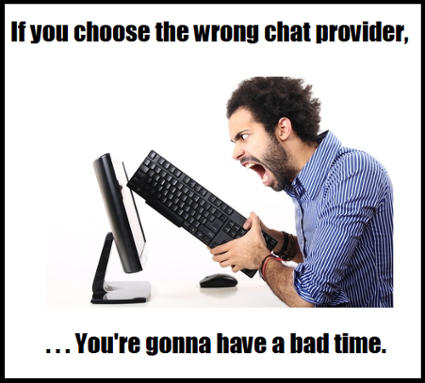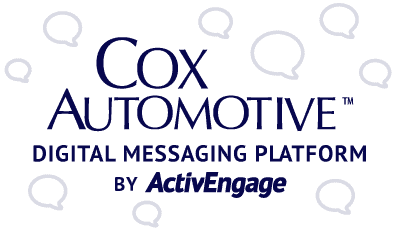
Wrong.
Yes, the core functionality of chat is the same - shoppers click a button on your website and they can chat with someone. However, there are features and functionality either of the chat software itself or the team handling the chats on your behalf that can make or break the shoppers’ experience on your website.
Chat Providers Can Differ in the Following Ways:
- Chat Conversation Quality and Focus
- Options for Managed Chat, Chat Software Only, or a Combination of Services
- Entry Forms to Get Into the Chat
- Technology and Tools
- Payment Structure
- Where You Can Chat (Your website, third party sites, social media, etc.)
- Philosophy on Time Availability (24/7 vs. Business Hours)
- What Departments You Can Chat For (Some providers have an extra cost if you want to chat for your service or parts departments)
- Co-op Program Availability through OEMs
- Location of the Chat Team (One location, multiple locations, outsourced)
- Level of Training
- Automotive Specific Provider or Chats for Multiple Industries
- In-House vs. Outsourced Support Team (or no Support Team at all)
- How They Handle Bilingual Chats (Translation, In-Staff Bilingual Chat Reps, or No Plan)
- Level of Analytics, Reporting, and Business Intelligence
- Compatible with Mobile
- Additional Chat Features (Such as Behavioral Invites, Text-to-Chat, Targeted Incentives, Test Drive Videos, Gamification, Toolbars, etc)
- ROI Predictions
3 Factors to Identify Bad Managed Chat
- The chat team is more focused on getting contact information than getting helpful information about the shopper’s needs
If you see your chat provider is quickly asking for contact information multiple times before gathering any details about the shopper’s interests, then you have bad managed chat. Good managed chat always strives to get the “good-to-know” information that your sales team can use to close the sale.
- Outsourced staff that does not speak English very well
Chat Receptionist: How soon are you planning to purchase?
Visitor: asap!
Chat Receptionist: Sorry?
In the conversation above, the chat receptionist doesn’t understand the acronym “ASAP”, which is commonly used in the English vernacular, but may be a foreign expression to an outsourced chat provider. When you have a managed chat provider who employs an outsourced team, you run the risk of miscommunication.
- Chat representatives are unable to answer simple vehicle knowledge questions
You: what is the towing capacity? [Referring to a 2011 F-150 in their inventory]
Chat Receptionist: I will have to check on that with my manager, we cna email you the full details and specs on that model
Chat Receptionist: What is your email?
You: you don't know that?
[Waited 2 minutes and 22 seconds]
You: hello?
[Waited another 2 minutes]
You: are you still there?
Chat Receptionist: I do not have it listed
Chat Receptionist: We can email you that info!
You: ok. thanks
Chat Receptionist: What is your email?
If your team does not have the knowledge and tools to answer simple questions about towing capacity or other vehicle information, then you definitely have bad managed chat. A live chat service should always be helpful and answer the questions that can be answered, rather than dispersing the responsibility of answering simple questions to a manager at the dealership just so the chat team can get contact information for a lead.
3 Factors to Identify Bad Dealer-Managed Chat
- Long pickup times
The dealership staff is often focused on other assigned tasks, not just chat, and therefore can take longer to answer chat requests. Ideally, chats should be answered in 6 seconds or less to avoid shoppers dropping out of chat from waiting too long.
- Long response times
The same issue with multi-tasking has an effect on the length of response times for an in-house staff. Sometimes a dealership staff’s takes from 1-5 minutes to answer a question. However, today’s shoppers don’t want to wait, and if a question is not answered in 30 seconds or less, you run the risk of the shopper leaving the chat, clicking off your website, and going to a competitor.
- Focused on selling a car, rather than answering the shopper’s questions
The “Just Get Em In!” mentality doesn’t work for live chat. If your dealership’s staff is just trying to get the shopper to come in the store before answering any of the shopper’s questions, then you have bad in-house chat. Addressing the shopper’s questions should come first in chat. Always.
Looking at Chat Through the Consumer’s Eyes
Dealers, are you paying attention to the experience your consumers are receiving through live chat? Are you seeing when a chat receptionist doesn’t listen to your customer’s initial question, when they take FOREVER to respond, or when they say things like this:
Visitor: my car is totaled
Visitor: so i'm in need of a new one soon
Chat Receptionist: That's wonderful news! Let me gather all information regarding the Chevrolet Lumina with stock number CB24025R and have my Internet Manager contact you the soonest possible time.
Last time I checked...totaling your car was NOT wonderful news. And a chat representative should never say so.
If your shoppers have a bad time in a chat conversation, they will leave your site. They won’t call the store to complain to a manager. They just leave without so much as a peep. And will probably never come back again. You won’t ever know they had a bad experience unless you monitor the chats taking place on your site. Your dealership’s reputation depends on it.
Hopefully, you now understand why having bad chat on your website is more detrimental to your business than having no chat option at all. It is not worth the cost to your business and reputation. So, if you do decide to add live chat to your website, choose wisely and always do extensive research - such as test chatting- before you buy.









